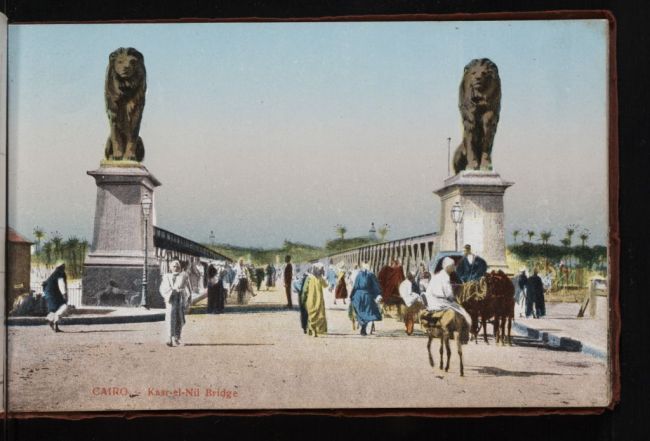Caveat Emptor
Before we delve into the charts to analyse the results, a word of caution: while the results for the individual candidacy (IC) districts are official, there will be runoffs in all but four districts on Monday, and there could still be changes due to legal challenges due to campaign violations. Still, there is valuable information to be mined here for various purposes: seeing who the runoffs are between and voting accordingly — for instance if you're a liberal can't stand the Salafists, you might vote for their Muslim Brotherhood competitor just to ward them off, or conversely you may want to seek out those districts where a non-Islamist may still stand a chance. Likewise if you're a Muslim Brother, this shows which districts are battlegrounds to concentrate on — there are many districts split between Salafists and Brothers, for instance.
Even more caution is necessary with the proportional representation (PR) districts, for which all results and estimates used below have been collated from the media, since there have been no official announcements. Eventually, for both IC and PR districts, it will be fascinating to see the complete information on the votes cast — anecdotally, we for instance know that in a place like Fayoum district #2 — mostly split between the Salafists and the Brothers — one-third of votes got wasted on tiny parties that stood no chance.
For the meantime, considering the appalling lack of diligence and transparency of the Higher Elections Commission, we must make do with what we have.
The big picture
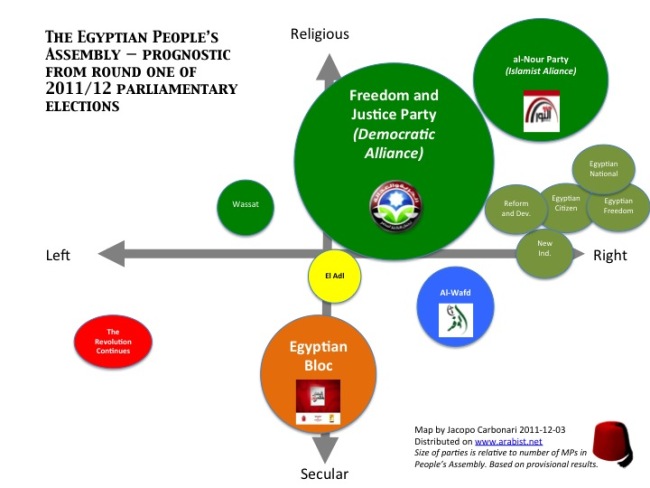 The above map, based on our previous chart of Egypt's political parties, represents more or less the ones that have garnered enough votes to count, with each party represented according to the number of seats it obtained (or may obtain following runoffs). This picture is unlikely to change much in the remaining two rounds, and shows three big political forces: The Muslim Brothers' FJP, the Salafists (especially the Nour Party), and the Egyptian Bloc alliance led by the Free Egyptians and the Social Democratic Party. Get this chart in PDF.
The above map, based on our previous chart of Egypt's political parties, represents more or less the ones that have garnered enough votes to count, with each party represented according to the number of seats it obtained (or may obtain following runoffs). This picture is unlikely to change much in the remaining two rounds, and shows three big political forces: The Muslim Brothers' FJP, the Salafists (especially the Nour Party), and the Egyptian Bloc alliance led by the Free Egyptians and the Social Democratic Party. Get this chart in PDF.
The breakdown
Both the breakdowns of IC and PR races are important, but differently: for IC, the runoffs are on Monday and voters will be interested to see if their candidate of first choice made it, and if not who else they might vote for. This will be particularly important for voters interested in avoiding a certain type of candidate (say across the Islamist-secular divide) and, because there are so many FJP vs. Nour races, there will be a lot of incentives for the Muslim Brothers to rally secularists to their side with the argument that at least they are not Salafists. Or, for some people who can't stand the Muslim Brothers, to back the Salafists to make sure they don't get in (this sentiment may very well be prevalent considering the bad press the Brothers have gotten from the regime over the last few decades as agents of Iran, Hamas, freemasonry, etc.)
Here's a graphic representation of the first round, pre-runoff results for both IC and PR I put together that should enable readers to quickly see the hot races. For details on who is running, we have a full list of the IC results (and some PR results) at the bottom of this post that includes the candidates' names.
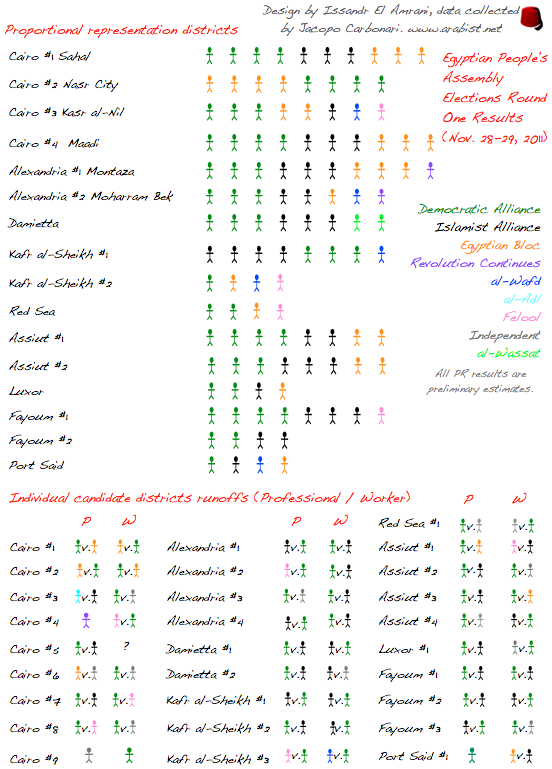
You'll probably want to download the PDF version of this image, which is a lot easier to read and is formatted to be printed on A4 paper (in color obviously). Our count makes the runoffs as follows:
FJP v. Nour: 22
FJP v. EB: 6
FJP v. felools: 4
FJP v. independents: 10
FJP v. Wafd: 1 |
Nour v. EB: 1
EB v. Independents: 1
Nour v. Adl: 1
Felool v. Nour: 1
Nour v. independents.: 1 |
As the two leading parties nationally, the FJP and Nour are running close races in a lot of districts. But the third party, the Egyptian Bloc, also has a chance at getting an additional 8 seats, although it tends to be the underdog. Cairenes alone have a chance at getting another four MPs from the Egyptian Bloc.
The full data that went into making these charts is available in PDF. It includes full results when available or at least, for PR districts, the order in which the parties came. Please let us know in the comments if you spot any errors.
Wait, there's more
I'd also like to highlight a couple of other charts a reader sent in.
The first one, by Mostafa El-Hoshy compares Salafist vs. other Islamist votes:
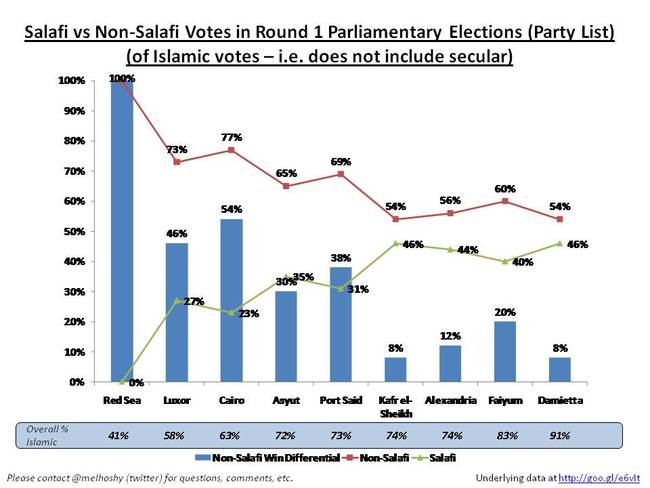 By Mostafa El-Hoshy — click for full sizeThe chart shows the degree to which voters went for Islamist parties generally — over half in most places and about two-thirds generally, and then the split among Islamist parties between the Salafists and the rest (i.e. mainly the Muslim Brotherhood.) What's striking here is that while the Brothers have the lead generally, their margin (the non-Salafi Win Differential) is quite small along the northern Delta and in the Fayoum — all places where the Brothers have a long-established presence. We still have much to learn about the Salafist electoral machine, but that alone is quite an achievement considering they never ran for office before. Whether it's grassroots, money or effective campaigning remains a mystery to me.
By Mostafa El-Hoshy — click for full sizeThe chart shows the degree to which voters went for Islamist parties generally — over half in most places and about two-thirds generally, and then the split among Islamist parties between the Salafists and the rest (i.e. mainly the Muslim Brotherhood.) What's striking here is that while the Brothers have the lead generally, their margin (the non-Salafi Win Differential) is quite small along the northern Delta and in the Fayoum — all places where the Brothers have a long-established presence. We still have much to learn about the Salafist electoral machine, but that alone is quite an achievement considering they never ran for office before. Whether it's grassroots, money or effective campaigning remains a mystery to me.
The second is also by Mostafa El-Hoshy, and compares Islamist vs. non-Islamist votes (I don't know whether parties such as al-Tayyar al-Masri, al-Adl, al-Wassat and others that may be "Islamist Lite" are included.) It's pretty self-explanatory.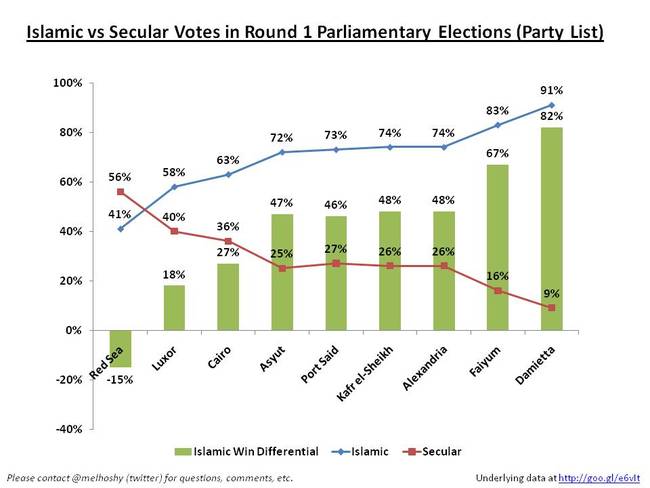 By Mostafa El-Hoshy — click to enlarge
By Mostafa El-Hoshy — click to enlarge
You can get the spreadsheet with data for these last two charts here.





